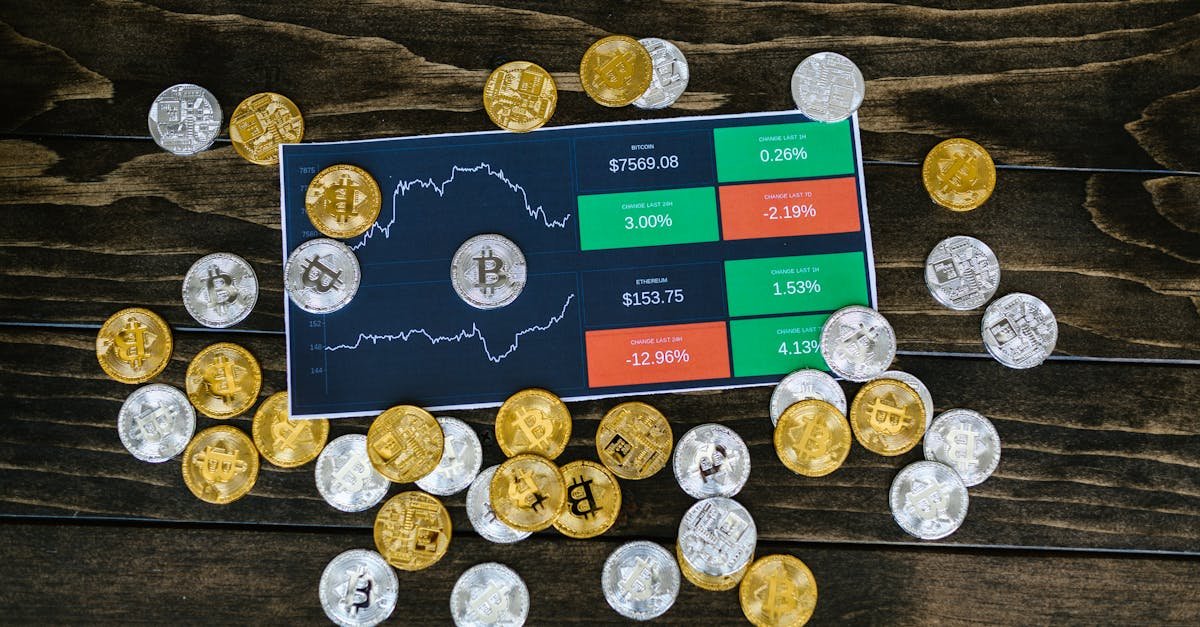Unlock the Future: Finding the Best Altcoins for Decentralized Finance Protocols
Hey there! Ever feel like traditional finance, with its banks and middlemen, is a bit… outdated? Like there should be a better, more open way to manage and grow your money? Well, you’re not alone! That’s where the exciting world of Decentralized Finance, or DeFi, comes in. Imagine a financial system built on blockchain technology – transparent, accessible to anyone with an internet connection, and without the need for traditional banks calling all the shots. It sounds like science fiction, but it’s happening right now!
But what powers this revolution? While Bitcoin started the crypto journey, it’s the altcoins – cryptocurrencies other than Bitcoin – that are really driving innovation in DeFi. These altcoins are the native tokens of sophisticated blockchain platforms that run smart contracts, the self executing contracts with the terms of the agreement directly written into code. Think of them as the digital fuel and building blocks for DeFi applications. We’re talking about platforms where you can lend, borrow, trade, earn interest (often called yield farming or staking), and so much more, all peer to peer.
Choosing the right horse to back in this race can feel overwhelming, right? There are thousands of altcoins out there. So, how do you find the best altcoins for decentralized finance protocols? Which blockchains have the speed, security, and growing ecosystem needed to support the next generation of finance? That’s exactly what we’re going to explore together. Forget the confusing jargon; let’s break down some of the top contenders in plain English, looking at what makes them tick and why they’re catching the eyes of DeFi enthusiasts and developers worldwide. Get ready to dive deep into the technologies shaping the future of money!
Ethereum’s Reign and the Rise of the Challengers: Solana and Cardano
Okay, let’s start with the big one: Ethereum (ETH). You simply can’t talk about DeFi without talking about Ethereum. It was the pioneer, the platform that first introduced smart contracts capable of supporting complex applications. Think of Ethereum as the foundational layer, the original bustling city where DeFi first took root. Most of the major DeFi concepts we know today – decentralized exchanges (DEXs) like Uniswap, lending protocols like Aave and Compound, yield farming strategies – they all blossomed first on Ethereum.
Why was Ethereum so revolutionary for DeFi?
- Smart Contracts: Its programming language, Solidity, allowed developers to build sophisticated financial applications that could run automatically and transparently on the blockchain.
- Network Effect: Being the first mover gave Ethereum a massive head start. It attracted the most developers, users, and capital, creating a vibrant and interconnected ecosystem. Liquidity, the lifeblood of finance, flowed heavily into Ethereum’s DeFi protocols.
- Decentralization: While debates exist, Ethereum has a large, globally distributed network of nodes and validators, making it relatively resistant to censorship and control by any single entity. This aligns perfectly with the core philosophy of DeFi.
However, Ethereum’s incredible success also led to significant growing pains. Imagine that bustling city becoming *too* popular. The streets (the network) get congested, and the cost of doing anything (transaction fees, known as “gas fees”) skyrockets. During peak times, using DeFi apps on Ethereum could cost hundreds of dollars in fees, pricing out smaller users. Transaction speeds could also slow down considerably. This created a massive opportunity for other blockchains – often dubbed “Ethereum Killers” – to step in and offer solutions. They aimed to provide faster speeds, lower costs, and better scalability, hoping to attract users and developers frustrated with Ethereum’s limitations. Two of the most prominent challengers in this space are Solana (SOL) and Cardano (ADA).
Solana (SOL): Built for Speed
If Ethereum is the established, sometimes congested city, think of Solana as the newly built metropolis designed with high speed monorails from the ground up. Solana burst onto the scene with a primary focus: raw speed and throughput. It boasts the theoretical capacity to handle tens of thousands of transactions per second (TPS), compared to Ethereum’s historical average of around 15 30 TPS (though this is improving with upgrades).
How does Solana achieve this incredible speed?
- Proof of History (PoH): This is Solana’s secret sauce. It’s not a consensus mechanism itself (Solana uses Proof of Stake for consensus), but rather a way to create a verifiable, chronological record of events on the blockchain *before* they are bundled into blocks. Imagine a super fast, trustworthy clock built directly into the network. This allows validators to process transactions much more efficiently without having to constantly communicate back and forth to agree on the order of events.
- Optimized Architecture: Solana uses various other technical innovations like Turbine (a block propagation protocol) and Gulf Stream (a mempool-less transaction forwarding protocol) all designed to minimize bottlenecks and maximize speed.
This focus on speed and low transaction costs (often fractions of a cent) made Solana incredibly attractive for certain types of DeFi applications, especially those requiring high frequency trading or interactions, like decentralized exchanges and derivatives platforms. Its ecosystem exploded rapidly, attracting significant investment and developer talent. Popular Solana DeFi projects include:
- Raydium: An automated market maker (AMM) and liquidity provider built on the Serum decentralized exchange (which itself leverages Solana’s speed for an on chain central limit order book).
- Marinade Finance: A popular liquid staking protocol allowing users to stake their SOL and receive mSOL tokens, which can then be used in other DeFi applications while still earning staking rewards.
- Orca: Another user friendly AMM known for its focus on usability and capital efficiency.
However, Solana isn’t without its challenges. The very complexity that enables its speed has also led to network instability at times. Solana has experienced several significant outages where the network slowed down drastically or stopped processing transactions altogether. These incidents raised concerns about its reliability and decentralization, as restarting the network required coordination among validators. While the developers are constantly working to improve robustness, these events highlight the trade offs often involved in prioritizing raw speed. Furthermore, while validator hardware requirements are decreasing, running a Solana validator has historically been more demanding than for some other networks, leading to concerns about potential centralization.
Investing in SOL means betting on the team’s ability to overcome these technical hurdles and maintain network stability while continuing to foster its rapidly growing DeFi ecosystem. Its potential for high throughput applications remains a major draw, making it a key player among the best altcoins for decentralized finance protocols, especially for those prioritizing speed and low fees.
Cardano (ADA): The Research Driven Approach
If Solana is the speed focused metropolis, Cardano is more like a meticulously planned city built phase by phase based on extensive academic research and peer review. Founded by Ethereum co founder Charles Hoskinson, Cardano takes a fundamentally different approach. Its development is characterized by a methodical, research first philosophy, emphasizing formal verification and long term sustainability.
What makes Cardano unique?
- Ouroboros Proof of Stake: This is Cardano’s consensus mechanism. It was one of the first PoS protocols developed with rigorous academic analysis and mathematical proofs to back its security claims. It’s designed to be energy efficient and securely scalable.
- Layered Architecture: Cardano separates its blockchain into two main layers: the Cardano Settlement Layer (CSL) for handling ADA transactions, and the Cardano Computation Layer (CCL) where smart contracts and decentralized applications run. The idea is that separating these functions allows for greater flexibility and easier upgrades. For example, regulations around identity or computation could potentially be addressed on the CCL without disrupting the core settlement layer.
- Peer Reviewed Research: Major developments and protocol upgrades on Cardano are typically based on academic papers that have been peer reviewed, aiming for a higher degree of certainty and security before implementation. This often means development can seem slower compared to competitors, but the goal is to build a more robust and future proof foundation.
- Focus on Interoperability and Sustainability: Cardano aims to be interoperable with other blockchains and even traditional financial systems. It also has an on chain treasury system (Project Catalyst) where ADA holders can vote on funding proposals for ecosystem development, fostering a sense of community ownership and long term sustainability.
Cardano’s smart contract capability (via the Plutus platform) launched later than on some other chains, meaning its DeFi ecosystem is younger and less developed compared to Ethereum or even Solana. However, it has been steadily growing since the Alonzo hard fork enabled smart contracts. Some emerging Cardano DeFi projects include:
- Minswap: A multi function decentralized exchange offering features like yield farming and staking.
- SundaeSwap: One of the earliest and most well known DEXs on Cardano.
- Indigo Protocol: A protocol for creating synthetic assets (assets that mimic the value of real world assets or other cryptos) on Cardano.
- Liqwid Finance: An open source lending and borrowing protocol.
The primary criticism leveled against Cardano is its slower pace of development and ecosystem growth. The “measure twice, cut once” philosophy means features sometimes take longer to arrive compared to competitors who might prioritize speed to market. Some also argue that its EUTXO (Extended Unspent Transaction Output) model, while theoretically powerful, presents different challenges for DeFi developers used to Ethereum’s account based model, potentially steepening the learning curve. However, proponents argue this deliberate pace leads to a more secure and sustainable platform in the long run.
Investing in ADA is often seen as a longer term bet on the value of academic rigor, formal methods, and a community governed approach to building a global financial operating system. While its DeFi ecosystem is still maturing, its strong community, unique architecture, and focus on sustainability make it a fascinating contender and a potential candidate for the best altcoins for decentralized finance, especially for those who value methodical development and security proofs.
Both Solana and Cardano offer compelling alternatives to Ethereum, albeit with very different philosophies and technical approaches. Solana prioritizes speed and throughput, attracting applications that need rapid execution, while Cardano emphasizes research, security, and deliberate development. Understanding these differences is key when evaluating which ecosystems might best suit your interests or investment thesis within the dynamic world of DeFi.
Beyond the Titans: Exploring Avalanche, Polkadot, and the Interoperable Future
While Ethereum holds the historical crown and Solana and Cardano represent major philosophical forks in the road, the quest for the perfect DeFi platform doesn’t stop there. Several other exciting projects are carving out significant niches, often focusing on novel approaches to scalability, interoperability, or specific types of DeFi applications. Let’s zoom in on two more heavyweights, Avalanche (AVAX) and Polkadot (DOT), and consider the broader trend towards connecting these diverse ecosystems.
Avalanche (AVAX): Speed Meets Customization
Imagine a network that’s not just one blockchain, but a platform for launching *many* blockchains, all interconnected and benefiting from incredible speed and security. That’s the core idea behind Avalanche. It aims to solve the scalability trilemma (the challenge of simultaneously achieving decentralization, security, and scalability) through a unique architecture and consensus mechanism.
What sets Avalanche apart?
- Avalanche Consensus Protocol: This is a novel consensus mechanism that differs significantly from Bitcoin’s Proof of Work or traditional Proof of Stake. It involves nodes repeatedly sampling small, random subsets of other validators to quickly determine if a transaction is preferred by the network. This allows for very fast transaction finality – the point at which a transaction is considered irreversible – often achieving finality in under two seconds. This near instant finality is a huge plus for DeFi applications where users need certainty quickly.
- Subnets (Subnetworks): This is arguably Avalanche’s most powerful feature. Anyone can create their own customized blockchain (a subnet) on Avalanche. These subnets can have their own rules, their own virtual machines (like the Ethereum Virtual Machine, EVM, or a custom one), their own fee structures, and even their own tokens for paying gas fees. Crucially, validators on these subnets must *also* validate Avalanche’s primary network. This means subnets inherit the security of the main Avalanche network while offering tailored environments for specific applications or even large enterprises wanting their own blockchain. Think of it like building specialized industrial parks or residential zones connected to the main city’s infrastructure.
- Three Chain Architecture: Avalanche’s primary network itself is composed of three interconnected blockchains:
- X Chain (Exchange Chain): Used for creating and trading assets (like AVAX itself). Uses the Avalanche consensus.
- P Chain (Platform Chain): Coordinates validators, tracks subnets, and allows for the creation of new subnets. Uses the Snowman consensus (optimized for linear chains).
- C Chain (Contract Chain): This is where most DeFi activity happens. It runs the Ethereum Virtual Machine (EVM), meaning developers can easily port popular Ethereum applications over to Avalanche. It also uses the Snowman consensus. This EVM compatibility was a major catalyst for Avalanche’s rapid DeFi growth.
This combination of speed, near instant finality, EVM compatibility via the C Chain, and the flexibility of subnets has made Avalanche a very attractive platform for DeFi development. It quickly attracted established Ethereum DeFi protocols looking for a faster, cheaper environment, as well as native projects. Some prominent Avalanche DeFi players include:
- Trader Joe: Started as a DEX, but has evolved into a comprehensive DeFi platform offering lending, borrowing, staking, and launchpad services. Known for its community focus and innovative features.
- Aave & Curve: These major Ethereum lending and stablecoin exchange protocols deployed versions on Avalanche, bringing significant liquidity and trusted brand names to the ecosystem.
- Benqi: A native Avalanche liquidity market protocol offering lending, borrowing, and liquid staking (sAVAX).
- GMX: While also on Arbitrum (an Ethereum Layer 2), GMX gained significant traction on Avalanche as a decentralized perpetual exchange.
What are the potential downsides or considerations for Avalanche? While the consensus mechanism is fast, its theoretical underpinnings are newer and less battle tested over long periods compared to something like Bitcoin’s Proof of Work or even Cardano’s researched Proof of Stake. The subnet model, while powerful, also relies on attracting enough value and activity to incentivize validators to secure those subnets. If a subnet isn’t popular or valuable enough, it might struggle to attract sufficient validation, potentially impacting its security. Furthermore, while the C Chain is EVM compatible, interacting across the different chains (X, P, C) can sometimes add a layer of complexity for users.
Investing in AVAX reflects a belief in its innovative consensus mechanism and the power of the subnet architecture to create a scalable and customizable ecosystem for diverse applications, including and beyond DeFi. Its rapid growth and strong DeFi presence make it a key contender among the best altcoins for decentralized finance protocols, particularly for those interested in EVM compatibility combined with high speed and the potential for application specific blockchains.
Polkadot (DOT): The Internet of Blockchains
Where Avalanche focuses on creating customizable blockchains within its own ecosystem, Polkadot has a grander vision: connecting *all* blockchains, whether they are built on Polkadot or exist independently like Bitcoin or Ethereum. Think of Polkadot not as a single highway, but as the blueprint and construction crew for building bridges and tunnels to connect separate blockchain islands, allowing them to communicate and share information securely.
How does Polkadot aim to achieve this interoperability?
- Relay Chain: This is the heart of Polkadot. It doesn’t handle complex computations or smart contracts itself; instead, its primary job is to provide security and coordinate consensus for the entire network. It ensures that connected blockchains (parachains) are following the rules and that transactions spanning multiple chains are processed correctly.
- Parachains (Parallelized Chains): These are independent blockchains that connect to the Relay Chain. They can be specialized for specific tasks – one might be optimized for DeFi, another for identity management, another for gaming, and so on. They lease slots on the Relay Chain (typically through auctions where projects lock up DOT tokens) to benefit from its shared security and interoperability features. This allows parachains to focus on their specific function without needing to bootstrap their own validator set.
- Parathreads: Similar to parachains but with a pay as you go model. For projects that don’t need continuous connectivity to the Relay Chain, parathreads offer a more economical option to connect intermittently.
- Bridges: These are special components designed to connect Polkadot to external blockchains like Ethereum or Bitcoin, allowing for true cross chain communication and asset transfer.
- Substrate Framework: This is a powerful and flexible blockchain building framework developed by Parity Technologies (the core developers behind Polkadot). It makes it much easier for developers to create customized blockchains (parachains) that can easily plug into the Polkadot network. Many other independent blockchains also use Substrate.
- Kusama (KSM): Polkadot’s “canary network”. Kusama is an independent blockchain with nearly identical code to Polkadot but with faster governance and a more experimental environment. New features and parachains often launch on Kusama first to be tested under real economic conditions before potentially deploying to the more conservative Polkadot network. Think of it as Polkadot’s wilder, faster moving cousin.
Polkadot’s DeFi ecosystem is primarily developing *on* its parachains rather than directly on the Relay Chain. This means you need to look at specific parachains to find DeFi activity. Some key players include:
- Acala: A major DeFi hub for Polkadot, offering a stablecoin (aUSD), liquid staking (LDOT), and a DEX.
- Moonbeam: An EVM compatible smart contract parachain. This allows Ethereum projects to easily deploy on Polkadot and interact with other parachains, acting as a crucial bridge for existing DeFi applications.
- Astar Network: Another smart contract platform supporting both EVM and WebAssembly (WASM), aiming to be a multi chain hub connecting Polkadot to other Layer 1s and Layer 2s.
- Parallel Finance: Focuses on lending, staking, and yield optimization within the Polkadot ecosystem.
The main challenge for Polkadot is the complexity of its architecture and the auction system for securing parachain slots. Leasing a slot requires projects to lock up a significant amount of DOT, often acquired through crowdloans where community members temporarily lock their own DOT in support of a project. This can be a high barrier to entry. Furthermore, the user experience can sometimes involve navigating between the Relay Chain and different parachains, which might be less intuitive than interacting with a single monolithic chain. The success of Polkadot hinges on its ability to attract high quality parachains, build effective bridges to external networks, and demonstrate the tangible benefits of its shared security and interoperability model.
Investing in DOT represents a bet on the future being multi chain and interoperable. It’s a belief that specialized blockchains connected through a secure hub (the Relay Chain) will be more efficient and scalable than trying to do everything on one chain. Its focus on interoperability and the robust Substrate framework make it a unique and powerful platform, positioning DOT as a strategic asset for the interconnected future of decentralized finance.
Both Avalanche and Polkadot offer sophisticated solutions addressing the limitations of earlier blockchains. Avalanche provides high speed execution and customizability through subnets, while Polkadot focuses on securely connecting diverse, specialized blockchains. They represent different architectural bets on how the blockchain space will evolve, and both host burgeoning DeFi ecosystems worth exploring.
Wrapping Up: Navigating the DeFi Altcoin Landscape
So, we’ve journeyed through some of the most exciting blockchains powering the Decentralized Finance revolution. From the foundational work of Ethereum and its ongoing evolution, to the high speed ambitions of Solana, the research driven approach of Cardano, the customizable subnets of Avalanche, and the interconnected vision of Polkadot – it’s clear there’s no single “best” altcoin for DeFi. Each platform comes with its own unique technology, philosophy, strengths, and weaknesses.
What truly matters is understanding these differences:
- Ethereum (ETH): The original DeFi giant, huge ecosystem, battle tested, but faces scalability challenges (though improving with upgrades and Layer 2 solutions).
- Solana (SOL): Blazing fast speeds and low fees, great for high frequency applications, but has faced network stability issues.
- Cardano (ADA): Methodical, research focused development, strong emphasis on security and sustainability, but a younger, still developing DeFi ecosystem.
- Avalanche (AVAX): Near instant finality, highly customizable via subnets, EVM compatible C Chain fueling rapid DeFi growth, but newer consensus and reliance on subnet adoption.
- Polkadot (DOT): Focus on interoperability and connecting specialized blockchains (parachains) via shared security, robust development framework (Substrate), but complex architecture and parachain auction model.
The best altcoins for decentralized finance protocols for you will depend on your priorities. Are you looking for the most established ecosystem? The fastest transactions? The most scientifically rigorous approach? Or the platform best positioned for an interoperable, multi chain future? Maybe you’re interested in specific DeFi applications like yield farming, staking through liquidity pools, or using decentralized exchanges, and you find a particular platform excels in that niche.
The DeFi space is incredibly dynamic. New innovations, upgrades, and even entirely new blockchains are constantly emerging. Remember that investing in any cryptocurrency, especially altcoins focused on a rapidly evolving sector like DeFi, carries significant risk. Prices can be highly volatile, technology can encounter unforeseen problems, and regulations are still developing.
Ready to Explore Further?
This exploration is just the beginning! The world of DeFi and the altcoins that power it is vast and fascinating. Don’t just take my word for it. Dive deeper into the projects that caught your eye. Read their whitepapers (or summaries!), explore their ecosystems, maybe even try out some DeFi applications on a testnet or with a small amount of capital you can afford to lose. Join their communities on social media or forums to get a feel for their direction and developer activity. Remember, knowledge is your most powerful tool in this space. Conduct thorough research, understand the risks involved, and never invest more than you can afford to lose. The future of finance is being built today – are you ready to be a part of it?









